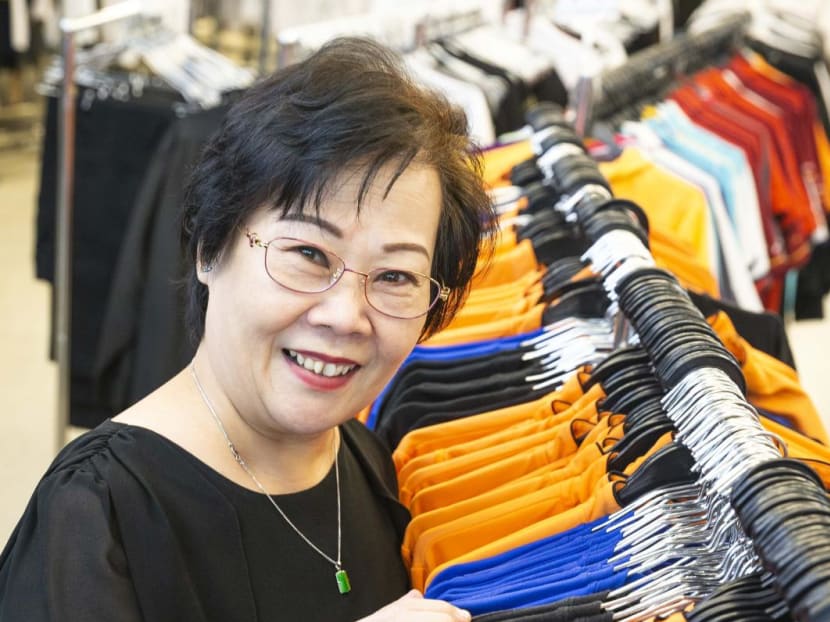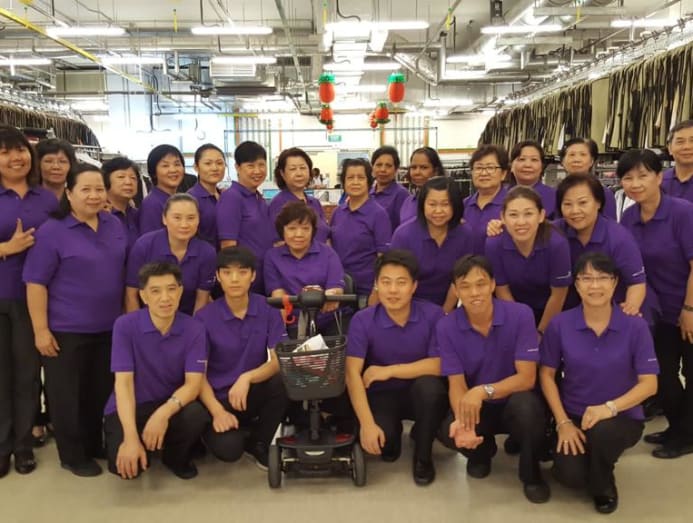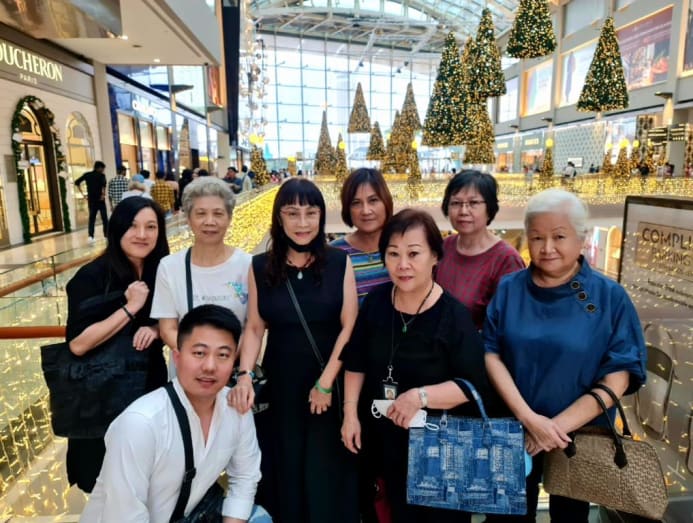Marina Bay Sands' 68-year-old wardrobe mistress is in charge of 170,000 uniforms: ‘I’m fascinated by the technology’
Helen Tan began her career in the 1970s, doing laundry. Today, she's the keeper of a highly advanced tech system that processes hundreds of thousands of staff uniforms at Marina Bay Sands – one of the largest hotel operations in the world.

Helen Tan, executive housekeeper or as she's better known – the wardrobe mistress – of Singapore's largest hotel, Marina Bay Sands. (Photo: Marina Bay Sands)

This audio is generated by an AI tool.
In a world dogged by constant dialogue on anxiety, fatigue and burnout, Helen Tan is a breath of fresh air.
Tan, 68, is the wardrobe mistress at Marina Bay Sands (MBS) and to truly understand what a massive undertaking that is, a couple of facts have to be made known.
MBS is the largest hotel in Singapore and sixth largest in Asia, with more than 2,200 rooms and suites. In 2011, less than a year after it opened, the integrated resort welcomed more than 30 million guests.
It is such a gargantuan operation that the hotel’s “back of house” is a whole “underground city” reminiscent of a subway interchange. It’s a sea of people, checking things in and out of lockers, pushing trolleys of luggage and garment bags, and hot footing it to the staff cafeteria for a free buffet lunch. There’s even a 7-Eleven.
Tan’s job is to make sure that every one of these employees is suitably dressed in a uniform that stands up to the hotel’s styling standards – evidently not a mean feat.
The uniform has to be altered to fit each individual’s body shape. It has to be comfortable and easy to move around in. It has to be spotless and essentially flawless – not a single thread out of place. And it has to be freshly laundered in time for each person’s shift and at a hotel, well – there’s someone clocking in practically every minute.
So it’s no surprise that the wardrobe department at MBS looks the way it does – like the self-serve warehouse at IKEA, except with clothes.

The lighting is a harsh white, like a camera flash, so flaws are easy to spot. There are 18 conveyors, each carrying 120 belts and every belt has slots for 620 sets of uniforms. Forget the math – the set-up can accommodate a mind-boggling 170,000 uniforms with approximately 160 different designs.
And this system runs every single day, 24 hours a day.
A few minutes into my tour of the 1,252 sq m space, I was at risk of straining my neck, trying to take it all in, when she interrupted my thoughts.
“You’re probably wondering how we manage,” she said.
“Technology,” she added, her eyes sparkling. Clearly, this is her favourite topic.
Each uniform is trackable, she explained. It’s equipped with a high-frequency (HF) chip that stores data such as who the uniform belongs to, its current location on the hotel premises, how many times it’s been laundered, plus whether or not it’s time for a replacement.
Staff are not encouraged to take their uniforms home – there’s no need to. The wardrobe department washes and presses the garments in time for their next shift. All they need to do is tap their staff pass on a door not much larger than Harry Potter's cupboard under the stairs, and the system simply "summons" their exact uniform and delivers it right into their hands.
“We are in the process of upgrading to UHF (ultra high-frequency) chips, which will help us read the data faster. So, instead of being able to scan only 10 pieces at a time, we’ll soon be able to push an entire trolley of uniforms (each trolley can take about 85 pieces) from the laundry into the ‘reading cabinet’ and we’ll be able to capture all the data we need,” she said.
The world is running out of tailors. We are lucky to have the seamstresses in our team
Tan isn’t just the keeper of all this tech. She also manages the people that keep its wheels turning – all 38 of them.
The total process of creating a uniform takes six months. The wardrobe department first works with an in-house stylist to brainstorm ideas for a uniform for a specific department, consulting with the department on requirements such as number of pockets needed, and the fabrics and other materials that are most suited for the environment the employees will be working in.
A vendor produces the uniforms and Tan’s team of tailors then steps in, rushing alterations to make sure the uniforms are a good fit for the hotel employees.
“The world is running out of tailors. We are lucky to have the seamstresses in our team,” Tan explained.
“We have 10 experienced tailors who work three shifts, eight hours each, and they rotate every once in a while. There isn’t a single day where there isn’t a team of tailors on standby – they work weekends and they work public holidays.”
With sewing being a dying art, it’s not surprising that most of Tan’s tailoring team is made up of seamstresses aged 60 and above. One is over 70 years old.
“They do shift work, full-time, and most have been with us since Day One.”
The wardrobe department also has seamstresses recruited from China who are in their 30s.
But the average age of the core team has me stunned. Exactly what is it about dressing hotel staff that makes one choose it over, well, retirement?
“THERE’S JUST SO MUCH TO LEARN”
Sitting across from her at her desk, I felt like I was in the school principal’s office. It’s a clean desk with a ’90s-looking desktop computer in a corner and behind her is a wall shelf holding plaques and trophies.
One said “You are magnificent”, which she tells me it was a gift by the hotel to the wardrobe department. There was also her long service award.
You have to tell yourself you’re here to learn something. It will be challenging, but you have to make it
Tan has been with MBS for 13 years, basically since its inception. She joined when she was already 55, undaunted by the fact that she would be managing the biggest team of her entire career.
Her career began at a Seaview Hotel, a chain that thrived in the 1970s but has since become a part of Singapore’s storied tourism history. She started out in the laundry department before upgrading to wardrobe.
“I’d always known how to sew. I learned it in school and before getting married and having kids, I used to make my own clothes. Working in the laundry department requires you to know not only how to sew, but to also develop a sense around what causes damage to a piece of fabric and how to restore it.
“When something happens to a piece of clothing after washing, you have to figure out what went wrong. Did the wash cause the ruin or was there a problem with the sewing?
“When a garment is damaged, you have to investigate to find out if it’s a workmanship problem or if the damage was caused by the wearer. There’s a troubleshooting element that can only be developed through experience,” she said.
Related:
As her career progressed, Tan joined the Four Seasons Hotel, where she was laundry manager. There, the laundry manager was also in charge of uniforms, a practice common in most hotels, simply because there were fewer rooms.
Several years into her stint at the Four Seasons, word of the Marina Bay Sands project began to get around.
“In the hotel industry, we all know each other. We connect often through the Singapore Hotel Association and the job opportunities at MBS were the talk of the town,” she told me.
“I’d heard about the large-scale technology that MBS had been planning to harness for its wardrobe department. That really attracted me to the possibility of working there. I wanted to learn about this new system.”
The hotel she was working in at the time had approximately 200 rooms. MBS was going to have thousands. But that didn’t throw her off. In fact, Tan, who was 55 at the time, was excited.

So when she was invited to apply, she jumped at it. The MBS operation was set to be so massive that she would be in charge of wardrobe and only wardrobe. Laundry would be handled by a separate department. Even so, the new role would require her to manage more people than she’d ever had. It would require her to also quickly master a completely new way of doing things.
“You have to tell yourself you’re here to learn something. It will be challenging, but you have to make it,” she said.
“WHEN YOU HAVE SUPPORT, YOU FEEL ENCOURAGED”
Thirteen years on, Tan is still thriving. She has no plans to retire. And her family is supportive of her decision, even though her husband, who was formerly in the construction industry, is now retired.
Synergy, it appears, is key to career fulfilment.
“Opening season was a very tough time. There were so many people involved and we had to mass produce, and I hadn’t produced on that kind of scale before. But every department supported each other and when you feel supported, you also feel encouraged. You tell yourself you have to carry on,” Tan shared.
“When you overcome challenges, like when staff come in saying they can’t find a uniform in their size and you do your best to make alterations, they come to you personally to thank you.
“That kind of consolation, that feeling of achievement … It makes you want to work harder,” she added.
As a manager, Tan herself is exemplary. During our conversation, she consistently compliments her “very strong team”. And she doesn’t believe in a one-size-fits-all approach.
“Listen,” said the mother of two, when asked about her experience with leadership. “And don’t just listen to one person. If one team member talks to you about someone or something, go to the source and find out more.
“Get feedback. Share your challenges with your team and listen to their challenges, then figure out the next steps together."
CNA Women is a section on CNA Lifestyle that seeks to inform, empower and inspire the modern woman. If you have women-related news, issues and ideas to share with us, email CNAWomen [at] mediacorp.com.sg (CNAWomen[at]mediacorp[dot]com[dot]sg).









